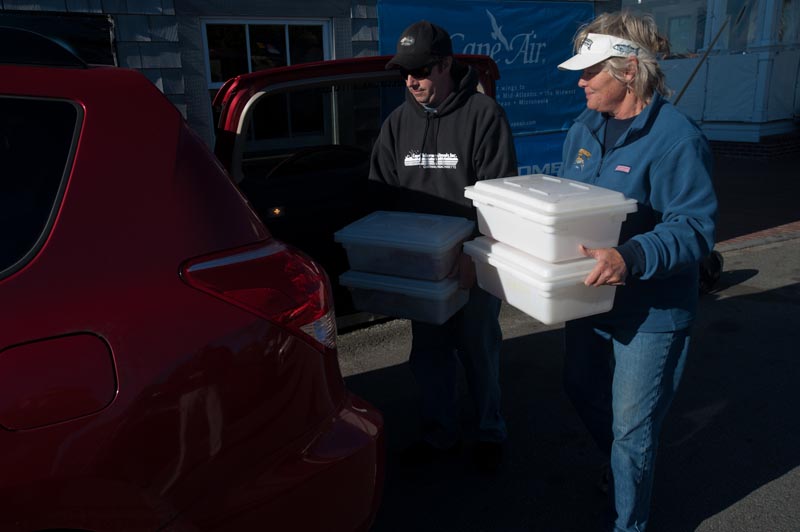There is always tough competition at the The Martha’s Vineyard Striped Bass and Bluefish Derby which these days attracts close to 3,000 fishermen. But amidst the awards and bragging rights there is also a tradition of generosity.
The derby committee has a floating fillet shack and will take whatever an angler donates and put it to good use. If it is a well-kept bluefish, bonito or striped bass, the fish is quickly filleted and placed into a refrigerator. The next morning volunteers show up at the headquarters and parlay the fillets to the local councils on aging centers for distribution.
“It is greatly appreciated by everyone,” said Joyce Stiles-Tucker, director of the Tisbury Council on Aging. “We had 20 people show up this morning. And we’ve had as many as 35 come.”
While there are plenty of reasons to appreciate a good tasty meal, Ms. Stiles-Tucker said most of the people who show up for the fillets are those on limited incomes. “This is a good thing for the derby to donate fish each year,” she said.
Ms. Stiles-Tucker said a crew of four people show up each Tuesday morning at the center to cull through the fillets and neatly wrap them in plastic bags for distribution. “They have a system and they all work very well together.”
Similar programs take place at the Oak Bluffs Council on Aging, the Up-Island Council on Aging and at The Anchors in Edgartown.
“We had over 30 people at one time,” said Paul Mohair, administrator of the Edgartown Council on Aging. He said most of the people taking advantage of the service are in need. “We have many Edgartown residents who are at the lower end of the economy, so this is very helpful. Free is always a good price,” he said.
Yesterday morning, Joyce Bowker, director of the Up-Island Council on Aging, showed up before 9 a.m. at the derby headquarters to pick up the last of the fish in the fillet program. Sue Peltier of Vineyard Haven, together with Geoff Codding, helped load Ms. Bowker’s vehicle.
Ms. Peltier said she has volunteered about five times this year. “I started filleting last year,” she said. “I wanted to learn how to get better at filleting. Nothing gets wasted and it is good to be helpful.”
Even false albacore, a fish few eat, is accepted at the fillet headquarters. The fish is put into a barrel and is picked up by Jason Gale, a local lobsterman, who freezes the fish to use as bait.
Mr. Gale said the bait he gets from the derby fillet program will last him through the coming year. “It will last me to August,” he said.
Chuck Hodgkinson, chairman of the derby, said the program is almost completely made up of volunteers. Eli Bonnell, who is at derby headquarters for each of the 35 evenings, gets a small stipend.
“We get a ton of volunteers that are not members of the derby committee who want to help,” said Mr. Hodgkinson. “Often they come to learn how to fillet fish faster. Some of the volunteers are members of the Martha’s Vineyard Surfcasters Association. Others just come by to chip in.”
Mr. Hodgkinson said the fillet program is a good first step for cultivating future derby volunteers. “It is a way to get involved,” he said. The filleter will usually wear oilskin pants, rubber boots and some kind of apron. “We provide the knives,” Mr. Hodgkinson said.
Doyle Bunch, 59, of West Tisbury said he volunteered three times during the derby. “I enjoy the derby so much, I just wanted to give something back,” he said.
“I was cutting off pieces of fish and feeding them to the sea gulls,” he continued. “I watched these children who were watching. They were having such a great time,”









Comments
Comment policy »